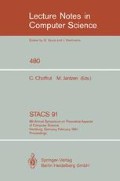Abstract
Conventional algebraic specifications are first-order. Using higher-order equations in combination with first-order ones raises several fundamental model-theoretic and proof-theoretic questions. The model theory of higher-order equations is well understood (see [20] for a survey of algebraic specifications). The proof theory of higher-order equations is equally well understood, it requires higher- order matching, and higher-order rewriting therefore providing with a simple execution model. Higher-order variables may be instantiated by functions described by λ-expressions, bringing in λ-calculus, whose execution model is again rewriting (β-redexes). Hence rewriting is at the heart of all three execution models, which makes their combination quite simple on the operational side. The main question reviewed in this paper is whether the Church-Rosser and termination properties of these three execution models are preserved within their combination. We will see that the answer is to a large extent positive.
This work was parly supported by the “Greco de programmation du CNRS” and the ESPRIT working group COMPASS.
Preview
Unable to display preview. Download preview PDF.
References
Henk Barendregt. Handbook of Theoretical Computer Science, volume B, chapter Functional Programming and Lambda Calculus, pages 321–364. North-Holland, 1990. J. van Leeuwen ed.
Val Breazu-Tannen. Combining algebra and higher-order types. In Proc. 3rd IEEE Symp. Logic in Computer Science, Edinburgh, July 1988.
Val Breazu-Tannen and Jean Gallier. Polymorphic rewriting conserves algebraic strong normalization. Theoretical Computer Science. to appear.
Hubert Comon. Completion of infinite rewrite systems. submitted, 1990.
Hubert Comon. Disunification: a survey. In Jean-Louis Lassez and Gordon Plötkin, editors, Computational Logic: Essays in Honor of Alan Robinson. MIT Press, 1990. to appear.
Hubert Comon, D. Lugiez, and Ph. Schnoebelen. Type inference in computer algebra. In Proc. EUROCAL 87, Leipzig, June 1987.
Nachum Dershowitz and Jean-Pierre Jouannaud. Handbook of Theoretical Computer Science, volume B, chapter Rewrite Systems, pages 243–309. North-Holland, 1990. J. van Leeuwen ed.
Daniel J. Dougherty. Adding algebraic rewriting to the untyped lambda calculus. Research report, Wesleyan University, USA, 1990. submitted.
K. Drosten. Termerssetzungssysteme. PhD thesis, University of Passau, Germany, 1989. In german.
K. Futatsugi, Joseph Goguen, Jean-Pierre Jouannaud, and J. Meseguer. Principles of OBJ2. In Proc. 12th ACM Symp. Principles of Programming Languages, New Orleans, 1985.
Jean Gallier. Logic and Computer Science, chapter On Girard's Candidats de Réductibilité. Academic Press, 1990. P. Odifreddi editor.
Jean-Pierre Jouannaud and Claude Kirchner. Solving equations in abstract algebras: A rule-based survey of unification. In Jean-Louis Lassez and Gordon Plötkin, editors, Computational Logic: Essays in Honor of Alan Robinson. MIT-Press, 1990. to appear.
Jean-Pierre Jouannaud and Mitsuhiro Okada. Embedding first-order and higher-order rewriting into lambda-calculus. Research report, University Paris Sud, 1990. submitted.
Aart Middeldorp. Modular Properties of Term Rewriting Systems. PhD thesis, Free University of Amsterdam, Netherland, 1990.
Mitsuhiro Okada. Strong normalizability for the combined system of the types lambda calculus and an arbitrary convergent term rewrite system. In Proc. ISSAC 89, Portland, Oregon, 1989.
Mitsuhiro Okada and X Grogono. Research report, Concordia University, 1990.
J. Tiuryn. Type inference problems: a survey. In Proc. MFCS 90, Banskà Bystrica, LNCS 452. Springer-Verlag, 1990.
Y. Toyama. Counterexamples to termination for the direct sum of term rewriting systems. Information Processing Letters, 25:141–143, April 1987.
Y. Toyama. On the church-rosser property for the direct sum of term rewriting systems. Journal of the ACM, 34(1):128–143, April 1987.
Martin Wirsing. Handbook of Theoretical Computer Science, volume B, chapter Algebraic Specification, pages 675–780. North-Holland, 1990. J. van Leeuwen ed.
Author information
Authors and Affiliations
Editor information
Rights and permissions
Copyright information
© 1991 Springer-Verlag Berlin Heidelberg
About this paper
Cite this paper
Jouannaud, JP. (1991). Executable higher-order algebraic specifications. In: Choffrut, C., Jantzen, M. (eds) STACS 91. STACS 1991. Lecture Notes in Computer Science, vol 480. Springer, Berlin, Heidelberg. https://doi.org/10.1007/BFb0020784
Download citation
DOI: https://doi.org/10.1007/BFb0020784
Published:
Publisher Name: Springer, Berlin, Heidelberg
Print ISBN: 978-3-540-53709-0
Online ISBN: 978-3-540-47002-1
eBook Packages: Springer Book Archive

